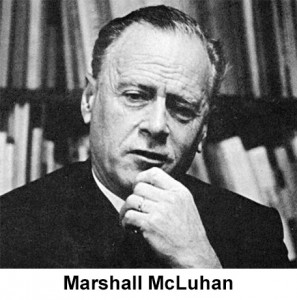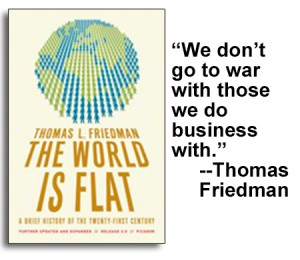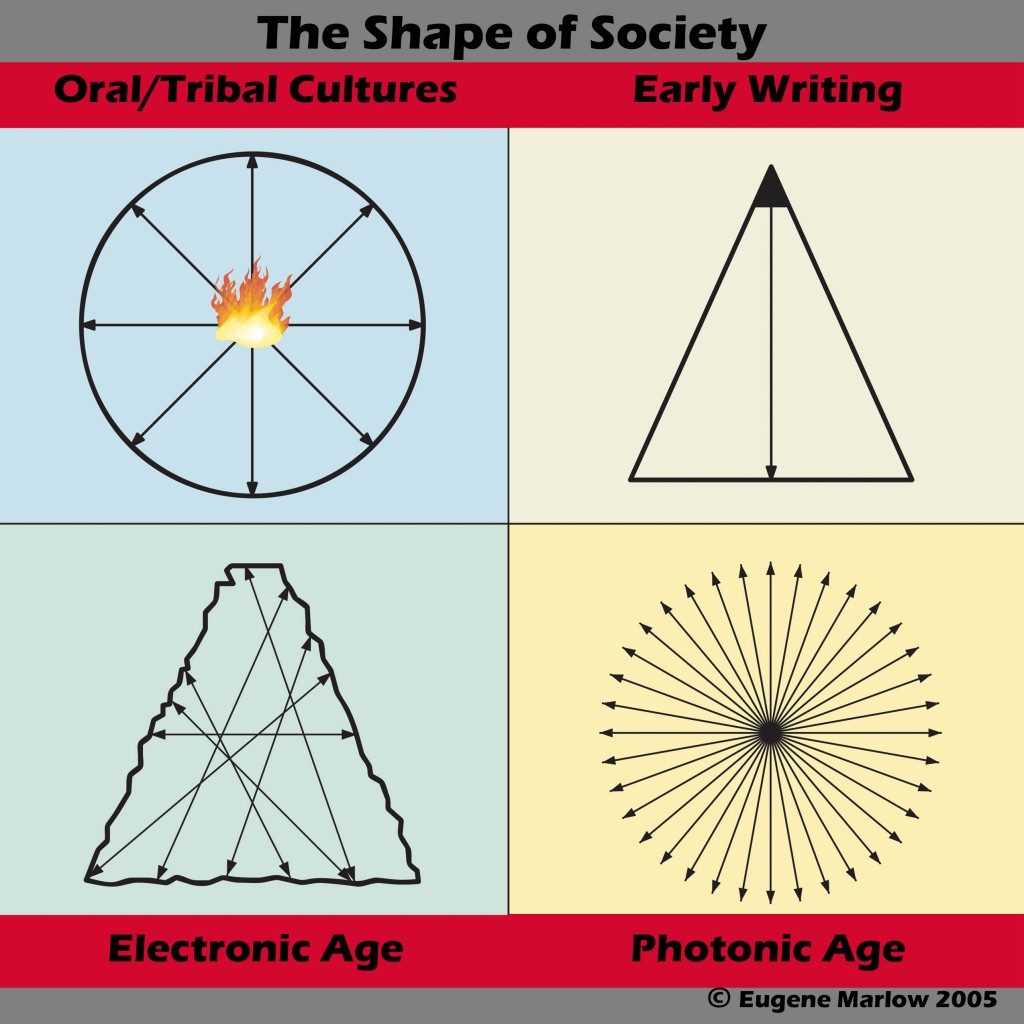In my opinion, every phase of our communications evolution has resulted in a particular shape that defines the characteristics of that society.
For example, it can be posited that early man—relying primarily on body language and orality to communicate—evolved a round-shaped, circular society. Those in the circle were part of the tribe; those outside, were not. Much of their architecture was round. Much in their environment was round: the sun, the moon, the eyes, the mouth, a woman’s breasts, a pregnant woman’s belly, it is nature overall—there are no straight lines in nature.
Early writing societies evolved a hierarchical, pyramid-like shape with those at the top in charge with everyone else beholden to the elite who could read and write. A strong part of the root cause is that effective and efficient writing requires delivery of letters and words in a straight line. Straight lines create structure. Structure creates division. Division creates hierarchy.
It could be argued that writing dissolved the relative equanimity of tribal life and the rule of nature and created the possibility of dictatorships and the rule of man. Writing created the dominance of the straight line found in many aspects of human life. It is not until after the introduction of the early printing press in the mid-15th century do we begin to see the wider application of the rule of law—a process that took several hundred years to evolve and continues to evolve.
The electronic age inaugurated with the commercial introduction of the telegraph and the concomitant acceleration of information dissemination to close to the speed of light ushered in a re-shaping of the hierarchical structure. The edges of societies’ structure became more malleable and the direction of information flows in many directions, not merely from top to bottom.
And now that we are in the photonic age (see my blog #87: “Beyond Electronics—A Speculation on a New Media Age”) with information moving even closer to the speed of light, societies have reached back to the earlier tribal circular shape while at the same time incorporating the capacity for communication in all directions, 360 degrees, 24/7—essentially on a global scale. To paraphrase a saying from the Cold War of the second half of the 20th century, today, when someone in Beijing, China sneezes, someone in Washington, D.C. says “gezuntheit.”
 So-called media guru Marshall McLuhan prophetically coined the phrase “the global village.” Whether he looked into a crystal ball or not, like Nostradamus is alleged to have done a few centuries earlier, it is evident the world has moved headlong into globalism with a vengeance as the flow of information has reached “instant” proportions. It is also true many communities have been created along ethnic lines. The desire for “cultural specialness” and the desire to express in many ways as possible that specialness—essentially the antithesis of the “melting pot” concept of the early part of the 20th century—has become even more present in the second half of the 20th century and the early 21st century.
So-called media guru Marshall McLuhan prophetically coined the phrase “the global village.” Whether he looked into a crystal ball or not, like Nostradamus is alleged to have done a few centuries earlier, it is evident the world has moved headlong into globalism with a vengeance as the flow of information has reached “instant” proportions. It is also true many communities have been created along ethnic lines. The desire for “cultural specialness” and the desire to express in many ways as possible that specialness—essentially the antithesis of the “melting pot” concept of the early part of the 20th century—has become even more present in the second half of the 20th century and the early 21st century.
The “artifactual” evidence that technologies based on photonics in many aspects of human life are now present is inexorable. And there will be more of it. But what other evidence can we point to that gives support to the contention that the age of photonics is upon us and its global effect on the shape of society is observable?
The first piece of evidence is the explosion of international organizations: political, professional, and personal. Strobe Talbott, head of the Brookings Institute in a speech at the Aspen Institute in the summer of 2008, pointed out that there are close to 8,000 international organizations operating on the planet. The expansion of the United Nations (U.N.) alone is further evidence of the growth of internationalism. At its birth in 1945 following World War II 51 countries were signatories to the U.N. charter. Today there are 192 countries. Many of the new counties admitted to the U.N. are built on ethnic or deep cultural heritage grounds. And there are several ethnic groups pressing their desire to create new countries based on their ethnic and cultural heritage: the Kurds in Northern Iraq; the French-Canadians in Quebec, Canada; the Basques in Spain; rebel groups in Georgia (of the former Soviet Union); and Chechens in Russia.
It has also become increasingly apparent that with each passing day nations are peering into and overtly commenting on the actions of other nations. An example of this is the multi-year long issue with the development of nuclear materials in Iran and North Korea. While Russia and the United States (and several other nuclear nations) attempt to reduce their respective nuclear arsenals, these two countries, in particular, are moving in the opposite direction, apparently in an ostensible attempt to sit at the table “with the big boys.”
 Environmental issues have certainly taken on global proportions. And last, but definitely not least, the globalization of the world’s economy (no redundancy intended) is “in your face” evidence that economically we are all inter-dependent. The economic crisis of the last several years, its roots notwithstanding, is clear evidence that everyone on the planet is in the global village together. Is multi-Pulitzer-prize winning author Thomas Friedman’s contention that we don’t go to war with those we do business with (in his book The World Is Flat) correct?
Environmental issues have certainly taken on global proportions. And last, but definitely not least, the globalization of the world’s economy (no redundancy intended) is “in your face” evidence that economically we are all inter-dependent. The economic crisis of the last several years, its roots notwithstanding, is clear evidence that everyone on the planet is in the global village together. Is multi-Pulitzer-prize winning author Thomas Friedman’s contention that we don’t go to war with those we do business with (in his book The World Is Flat) correct?
The history of the first half of the 20th century includes two world wars, the last of which ended with a big bang, atomic bomb explosion. But since then, the world has not gone to war on a global scale. Yes, there have been numerous local, even regional conflicts (such as the first Iraq war over Iraq’s invasion of Kuwait). And there have been several conflicts of a genocidal nature (Rwanda, Bosnia), but no multi-theatre war, i.e., in Europe, the Atlantic, the Pacific, the Far East. Yes, there is a war on terrorism—a war that does not share the characteristics of previous world conflicts, i.e., suicide bombings as a military tactic. If there is a conflict on a global scale it is in the economic arena, with China, India, Russia, and Brazil the leading aggressors.
Is the 360 degree, 24/7 shape of our planet in the early 21st century —politically, economically, culturally, and socially—a result of the photonic technology developments of 60 years ago? We are perhaps a little too close to the effects to state a definitive yes. But is it merely coincidental that the political, economic, cultural, and social developments of the last 60 years parallel the output of photonic technologies? I do not think so. A colleague, Dr. Eugene Secunda, and I wrote a book, Shifting Time and Space (Praeger 1991), on the evolution of videotape technology. From our research one conclusion was that as the technology evolved so did the applications. And as the technology became increasingly standardized and portable, so did the rapid deployment of the applications. Moreover, videotape evolved into the interactive videodisc, then the CD, then the DVD, and so on (underscoring again scholar George Basalla’s observation that a current technology product may not look the same as its antecedents, but they sure are in the lineage of the antecedents).
In other words, it is not mere coincidence that the electronic age that has evolved into the photonic age has also shaped in a short 180 years a globally evolving society.
Last, it stands to reason that what I have called the photonic age is not the end of the line. As I stated earlier, Homo sapiens have evolved through several communications stages of which photonics is the latest. It would be against the evolution of the universe to contend that “this is it.”
Please write to me at meiienterprises@aol.com if you have any comments on this or any other of my blogs.
Eugene Marlow, Ph.D.
December 2, 2013
*A version of this essay by Eugene Marlow originally appeared in Etc: A Review of General Semantics, Volume 66, Number 4, October 2009.
© Eugene Marlow 2013


